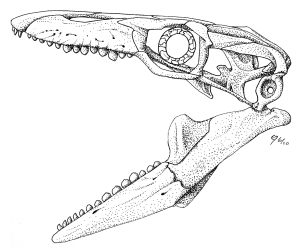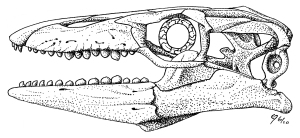Durophagy is technically the adaptations involving consuming foods that require crushing. At small scales, this can include insects, while at larger scales (where insects wouldn’t be consumed) this typically involves: cracking nuts, eating eggs, cracking crustacean or mollusk shells, etc. One of the most interesting durophages out there are the placodonts, but in the absence of any pretty pictures I’ve done recently of a placodont, here’s the next best thing: the durophagous mosasaur, Globidens dakotensis.

Schematic representation of the skull of quintessential globidont mosasaur, Globidens dakotensis, based on the holotype, FMNH PR846.
I lack the material to adequately discuss Globidens dakotensis here, but fortunately I don’t have to as Mike Everhart has done much on this behalf, especially as he’s seen virtually all of the material personally. Check it out. Most important among the material is the holotype (FMNH PR846), a nearly complete skull.

FHSM VP-13828, specimen referred to Globidens dakotensis (Russell, 1975), found in Kansas. From Everhart's Oceans of Kansas.
Globidens dakotensis Russell (1975) is actually the second species of Globidens, with alabamensis being the first and type (Gilmore, 1912), also based on a rostral dentary (USNM V6527).
This illustration is done to sketch out a durophage skull for my header (seen above), which is actually a crop of a larger image:
But there’s also a “mouth closed” version, to show how the skull would look in profile as it typically might have seemed were it just merrily swimming about minding its own business.
 I’ll probably fix the “coronoid outside the scleral ring” problem sometime.
I’ll probably fix the “coronoid outside the scleral ring” problem sometime.
Gilmore, C. W. 1912. A new mosasauroid reptile from the Cretaceous of Alabama. Proceedings of the United states National Museum 40(1870):489-484.
Russell, D. A. 1975. A new species of Globidens from South Dakota. Fieldiana Geology 33(13):235-256.




So, did Globidens lack the ability to physically close its mouth all the way?
[Based on your “mouth closed” illustration]
Hah! No, that’s my own slight error, in that instead of just closing the mouth, I left it slightly agape for aesthetic purposes. The fully closed mouth would look a lot neater than this, although I must confess I didn’t proportion the jaw accurately enough (largely because most of the post-dentary jaw is speculation). There will be an additional post on this, I assure you.